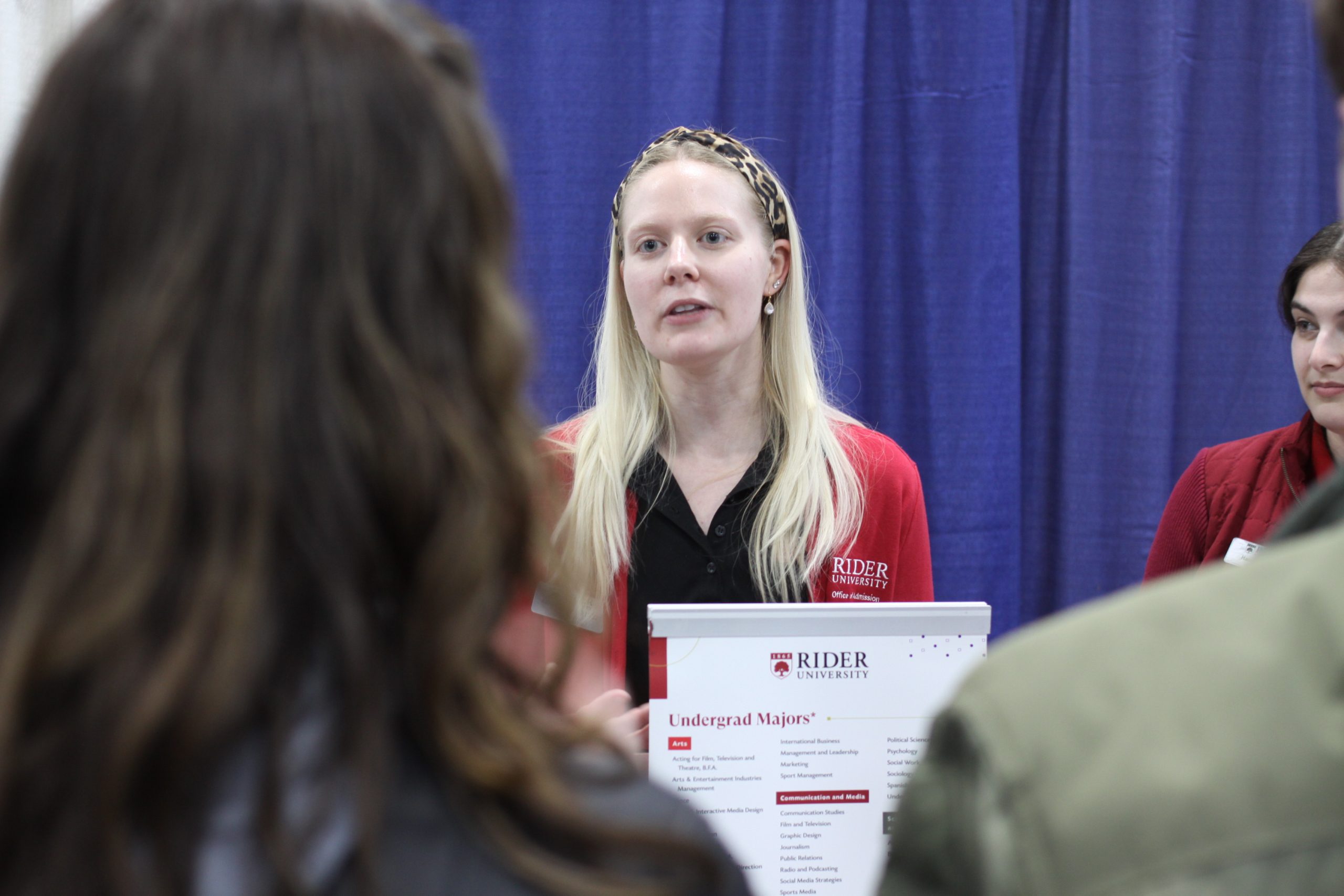Most Americans would probably rather forget the Great Recession that began in 2007. But as long ago as it may seem, it triggered something that is about to become a big problem: Americans started having fewer babies, and the birth rate hasn’t recovered since.
That means a looming decline in the number if 18-year-olds. Since those are the traditional customers for universities and colleges, enrollment is projected to fall dramatically and campuses to close.
In this episode, we tell you the surprising benefits of this for students and their parents — and the scary prospects for the economy, which will suffer shortages of workers just as baby boomers retire.
Come with us to a college fair where recruiters line up to compete for applicants, and hear from enrollment consultants, economists, and the president of a school that has already closed.
Listen to the whole series
TRANSCRIPT
[Kirk] This is College Uncovered. I’m Kirk Carapezza.
[Jon] And I’m Jon Marcus. We’re going to start this brand-new season of the podcast by taking you back to a time most Americans would probably rather forget.
[Archival news footage] Monday, Sept. 15, 2008. Lehman Brothers files the largest bankruptcy in U.S. history, precipitating the global financial crisis. … The Dow tumbled more than 500 points.
[Jon] What we now call the Great Recession started in 2008, and it left the world’s economy reeling.
[Archival news footage] More than two million prime mortgages, traditional loans for people with good credit, are now delinquent.
[Jon] The Great Recession did a lot of damage at the time, but it also caused something else most people haven’t noticed, and that’s about to affect us all.
[Archival news footage] Birth rates in the USA have dropped to their lowest annual levels in three decades, falling for nearly every group of women. … It changed the game when it comes to job security, and it led many young adults to delay marriage and kids.
[Jon] People stop having babies during economic downturns. That was a major but almost unseen impact of the Great Recession 18 years ago. And that means we’re about to run out of 18-year-olds. This is being called the demographic cliff.
Hey Kirk, help me explain the deal with this demographic cliff.
[Kirk] Yeah, so the demographic cliff is this big dropoff that’s about to hit the number of traditional-age college students. And the reason experts call it a cliff is that the number of students is going to go down, like you’re tumbling down a mountain and it never comes back up, Jon.
[Jon] The demographic cliff is pretty much the focus of our new season of this podcast. There’s some surprising good news that we’ll tell you about for students and their families, and for the parents of prospective college students. But this demographic cliff is also a big, big problem in ways most Americans don’t realize yet, for colleges and universities — and for economy.
[Nicole Smith] We are looking ahead down the road to circumstances, dire circumstances where we just can’t fill the jobs that are opening up.
[Wes Butterfield] We are at the, I’m going to call it the crossroads. You know, we’re at the cross roads for many campuses where they’re going to have to think creatively.
[Rachel Sederberg] We’re going to see issues across every occupation and every industry. There is going to be no one spared of this pain.
[Jon] Those are the voices of some experts whose job it’s been to watch this coming crisis. Like the lookouts with binoculars on the deck of the Titanic.
[Telephone ringing] Pick up, you bastards!
Yes, what do you see?
Iceberg! Dead ahead!
[Jon] So forgive us for the mixed metaphors and come with us as we help you cross these icy seas and this pivotal crossroads. We’ll show you how the demographic cliff will affect you.
[Kirk] This is College Uncovered, from GBH News and The Hechinger Report, a podcast pulling back the ivy to reveal how colleges really work. I’m Kirk Carapezza with GBH. …
[Jon] And I’m Jon Marcus of The Hechinger Report.
[Kirk] Colleges don’t want you to know how they operate, so GBH …
[Jon] … in collaboration with The Hechinger Report is here to show you.
[Kirk] In our fourth season, we’ll be looking at the many dramatic ways that college is changing right now and what it all means for you. Today on the podcast: “The Demographic Cliff.”
[Sound from college fair] Hi, guys, welcome to the college fair. If you’d like a bag…
[Kirk] To get a sense of what the demographic cliff looks and sounds like on the ground, I went to a national college fair in Edison, New Jersey.
[Sound from college fair] Students, make sure you have your barcode ready so the colleges can scan your barcodes.
[Kirk] Inside a massive convention and exposition center in an industrial park, a bunch of juniors and their families anxiously waited in the lobby before passing through turnstiles, and then they mingled with college representatives.
[Sound from college fair] And do you have one of the scan cards so I can get your information?
[Kirk] It’s kind of like speed dating, with most of the colleges here selling themselves.
[Sound from college fair] What’s cool about it is that we’re currently building our brand new college of business building that’s a lot of these that will be the biggest academic building on campus, so honestly your degree is going to work tenfold by the time that you end up coming to FSU.
[Kirk] There’s rows and rows of colleges. In some of those rows, it seems like there are more colleges than students.
[Sound from college fair] And we’re 10 minutes from London Heathrow Airport as well, so for international students getting on is great.
[Kirk] After the initial rush, the crowd thins out and those turnstiles stop turning.
Welcome to a new era of college admissions.
As you come to a fair like this, what are you looking for exactly?
[Brody Scully] I’m looking for environmental sciences and eco-engineering.
[Kirk] Brody Scully is a junior from West Milford, New Jersey. He says he knows exactly what he wants in a college: someplace where he can be active and maybe ski, and someplace small.
[Brody Scully] Because I definitely learn where there’s probably a smaller group of people, so I’m looking for that.
[Kirk] Is it anxiety-inducing for you guys, going through this process?
[Brody Scully] I would say yeah, definitely, and, like, time intensive.
[Kirk] Why is it so stressful?
[Brody Scully] There’s a lot of pressure on me. I have to decide in these next two years that I’ve got to go to a specific college.
[Kirk] But Brody may be in luck, because in the college admissions game, he was born at the right time: in 2008, just as birth rates in the U.S. started to decline. Remember Jon, that means there will be fewer 18-year-olds applying to college over the next few years. And except at elite schools like Harvard or Stanford and a few dozen other most selective colleges, the odds of getting in are going up. Eight out of 10 applicants to public universities and 7 out of 10 at private colleges are accepted now. That’s nearly 8 percentage points higher than 10 years ago.
Brody was surprised and thrilled when I told him this. In fact, his eyes widened.
[Brody Scully] I’m not aware of that at all and I’m kind of happy now that you told me that.
[Kirk] As the fair winds down, college reps, some standing alone in the back of the convention center, keep smiling, making eye contact, and hoping for just one more student to come by.
I mean, the reality is, this is a competitive landscape for many colleges, and for students, it’s increasingly a buyer’s market.
Take Rider University, which is trying really hard to stand out in this sea of schools. Its reps are simply telling potential students what the school is all about. and where it is.
[Susan Makowski] It is a small private school in Lawrenceville, New Jersey, which is about 15 minutes south of Princeton.
[Kirk] Susan Makowski is director of admissions at Rider, and for the past 20 years, she’s helped organize this fair.
This seems like organized chaos.
[Susan Makowski] I think that’s a great way to describe it.
[Kirk] This year, there are about 300 schools here looking for applicants. Colleges pay about $700 just to rent a booth. They think it’s worth it for a chance to connect with some of the nearly 3,000 registered students. And, of course, to scan their barcodes so they can follow up with endless reminders and marketing materials.
[Sound from college fair] I think I’m all good, but I’m making some…
Do you have one of the scans?
Uh, yes I do.
[Kirk] This year, Makowski tells me, Rider University is trying something a little different.
[Susan Makowski] Tonight, to be honest, I’m in New Jersey school at a New Jersey fair. I bought two booths. That’s how I’m standing out physically tonight so that you see that I’m here, right? You can’t miss me.
[Kirk] So you expanded your footprint.
[Susan Makowski] Yes, I did.
[Kirk] You can’t just walk, you can’t blow by you.
[Susan Makowski] Right, but that’s a selfish thing that I’m choosing to do, because I want to make certain that I can capture as many students Who might not have heard of us or might be really interested in us
[Kirk] Looking ahead and over the demographic cliff, Makowski tells me she knows things are about to change with fewer applicants.
[Susan Makowski] I think that’s going to be a natural progression, simply because a cliff is coming.
[Jon] Kirk, the seeds of this problem for colleges were planted back in 2008.
[Archival news footage] It was a manic Monday in the financial markets. The Dow tumbled more than 500 points after…
[Wes Butterfield] We were in a fairly dark place. And, again, that’s impacting us today.
[Jon] That’s Wes Butterfield. He’s chief of consulting services at Ruffalo Noel Levitz, a consulting firm that helps colleges and universities recruit students.
[Wes Butterfield] Anytime we reach those types of points in our history, birth rates go down. People just simply stop having babies. People were concerned about whether or not they’d have the resources to be able to start a family. And so those numbers backed off, and it takes a while for us to get to a point where it truly begins to impact us.
[Jon] The decline in births that started 18 years ago is about to translate into fewer students coming out of high school and enrolling in college. By 2039, there will be 15 percent fewer 18-year-olds per year than there are now.
The effect of all of this that you and I report about the most, Kirk, is what it will do to colleges and universities. It comes on top of a decline in enrollment that’s already been happening over most of the last 10 years. People have been questioning whether college is worth the high cost, and a relatively strong labor market drew a lot of high school graduates straight into jobs. Emily Wadhwani keeps a close eye on this as a senior director at Fitch Ratings, where she’s the sector lead for education. Fitch rates the financial health of institutions.
[Emily Wadhwani] We’ve been seeing kind of a trending downward of demand in terms of enrollment, particularly on the undergraduate side. So this is definitely a longer trend that we’re seeing.
[Jon] The pandemic only made things worse. And now the demographic cliff is here.
[Emily Wadhwani] Where we are now climbing back out of this post-pandemic recovery period, we see the same challenges that schools were facing prior to the pandemic, only now it’s more pronounced because those demographic trends have only deteriorated since then.
[Jon] That’s why colleges have started closing. Fitch categorizes the outlook for the higher education sector as deteriorating. Kirk, you and I have been seeing that a lot lately on abandoned campuses of colleges that have closed.
[Bob Allen] This is sort of a movie-set college campus, and people say that as soon as they essentially walk in the front gate.
[Kirk] That’s Bob Allen. He was the last president of a 185-year-old Green Mountain College in Vermont before it closed in 2019. By the time I visited the campus, it looked more like a ghost town.
[Bob Allen] So, yeah, watch yourself on these. They aren’t, see normally all of this would have been cleaned up.
One of the advantages of a small school is that it really was like an extended family. I knew not all of the students by name, but I knew most, and they knew me. They called me Bob, which was what I would prefer.
[Kirk] To Allen’s right, the red brick dining hall and dorms. To his left, the empty swimming pool, a ghost-like symbol of dried-up enrollment.
[Bob Allen] Increasingly students want to go to schools in cities and not rural areas. Poultney is a very tiny Vermont town.
[Kirk] At the time, Allen told me he preferred to give tours like these when the college was still open.
[Bob Allen] It was a lot more fun when we had students, all right.
[Kirk] At its peak, Green Mountain had about 800 students. That was already pretty small. But by the end of the 2010s, there were only a little more than half that many left. So Allen and his board decided that the college had to close.
[Bob Allen] It’s the hardest thing I’ve ever had to do personally. I spent most of my career building businesses and to take a 185-year-old institution and have to shut it down was really tough.
The demographics are working against all colleges, but in particular, small rural colleges. It’s tough for surrounding towns when colleges close too. Our payroll just for the college alone was $6 million. It has to, in the end, have an economic impact on the town. You know, some of the businesses had closed even long before we made our announcement.
[Jon] Kirk, the demographic cliff means there will be a lot more colleges closing. Don’t take it from us. That’s the prediction of the Federal Reserve Bank of Philadelphia. Already, 21 colleges defaulted on their bonds last year, or were at risk of defaulting. That’s way up. Here’s Emily Wadhwani from Fitch.
[Emily Wadhwani] We’ve seen the closure rate accelerate over the last few years. We expect to see that continue for the next few years. That has tended to be smaller, private, liberal arts, sometimes religiously affiliated schools with perhaps less than a thousand students. I’m generalizing; there are a couple outliers there, but broadly speaking, those are the types of schools that we’ve seen close.
[Jon] That’s a pretty good list of the kinds of colleges that are in trouble, and consumers need to keep that in mind. No matter what schools you’re considering, you need to do more these days than look at their courses or the athletics program. You need to check out their finances.
[Emily Wadhwani] The second place I would look is the strength of fundraising, often an indicator of the level of wealth the university has — the capacity to fund scholarships and other aid packages, less reliance on tuition as a primary means of operating revenue.
[Jon] We’ve talked before in this podcast about how you can see if your college might be in financial trouble. And we’ll post the link to that in the show notes.
Now, it’s obviously a sad situation when colleges close, for their employees and students and alumni, and for the towns that depend on them. But, Kirk, there are a couple of bright spots if you’re currently a college student or the parent of a college student, or have a child who’s considering college.
[Kirk] Yeah, Jon, colleges teach this in Econ 101. It’s the simple law of supply and demand. As the number of students is falling, there’s less demand. And as demand goes down, two things are happening. First, most colleges are becoming easier to get into. And second, the price of tuition has actually started falling.
[Jon] Now, Kirk, let’s be clear: College is still expensive, and to make up for keeping tuition low, colleges with dorms and dining plans are raising the price of food and housing. But increases in tuition are finally dropping when adjusted for inflation, after decades of exceeding the cost of almost everything else that Americans spend money on.
[Kirk] Exactly, Jon. You’re also likely to be able to negotiate for more financial aid. We gave a lot of advice about this in the first episode of our second season, and we’ll link that in the show notes too.
[Jon] We’ll have a lot more to tell you about the dramatic changes in admission in our next episode. So check that out.
[Kirk] So that’s all pretty good news for future students and their families. But there’s more bad news. And not just for colleges, but for the economy and society. There will be fewer graduates coming out the other end with skills employers need, and fewer young people in general available to work in any kinds of jobs.
[Jon] Right, and all of that, Kirk, is coinciding with the tidal wave of baby boomers who will be retiring at the same time.
[Rachel Sederberg] We’re already well underway in this process where we saw vast retirements over the last few years.
[Jon] That’s Rachel Sederberg, a senior economist and director of research at the labor market analytics firm Lightcast. Ten-thousand baby boomers are turning 65 every day. And Sederberg says there just aren’t enough workers coming up behind these retiring baby boomers to fill the jobs they’re leaving.
[Rachel Sederberg] The generations that follow the baby boomers are simply smaller and cannot mathematically make up for that decline.
[Jon] These shortages are already happening, Kirk.
[Rachel Sederberg] We are losing people across every occupation and industry. So we’re going to need more workers across, and we don’t have enough of any kind.
[Kirk] Okay, to tie this all together for you, we reached out to the Georgetown University Center on Education and the Workforce. It studies the connection between higher education and the economy. Chief Economist Nicole Smith connected these dots for us.
[Nicole Smith] So if you’re a college president, one way to look at this is, you know, ‘I don’t have enough students.’ But as an economist, I’m also thinking of the impact on the economy. Young people and young labor and the labor force — it’s the lifeblood of our society.
[Kirk] Smith says the decline in the number of traditional-aged college students will affect much more than whether a bunch of colleges close.
[Nicole Smith] We just don’t have enough who are completing and going to college and finishing school at as fast a rate as the economy is creating jobs for people with college degrees.
[Kirk] She’s not just talking about bachelor’s degrees, but all kinds of education after high school, including in manufacturing and the trades.
[Nicole Smith] Seventy-two percent of all jobs over the next decade will require some type of education and training beyond high school. So even if you don’t need a full bachelor’s, we need something that’s beyond high school and everyone has to be prepared to go back to get that credential so that you are prepared for that particular job.
[Kirk] So we’re all going to be falling down the demographic cliff together. In some parts of the country, labor shortages are already well underway.
[Nicole Smith] Many communities are facing this already. Rural communities are already having problems filling vacancies for some of their medical fields. They’re offering all sorts of incentives for doctors to come and work in those locations. So we’re already there.
[Jon] Kirk, as our experts have said, this demographic cliff is a dramatic turning point for higher education and it comes alongside questions about the value of college and a general decline in the proportion of high school students who are bothering to go.
[Kirk] Right, Jon, and that’s on top of huge political pressure on colleges and universities under the Trump administration and massive funding cuts.
[Jon] Throughout this season of the podcast, we’ll be looking at the ramifications of this unprecedented moment in the history of higher education. We’ll tell you how admissions is changing, why men in particular aren’t going to college, and the many new ways that are popping up, other than college, to train people for the workforce. and there’s much more.
[Kirk] So keep listening to future episodes to hear more about what colleges and universities don’t teach you in class.
This is College Uncovered. I’m Kirk Carapezza from GBH.
[Jon] And I’m Jon Marcus from The Hechinger Report.
[Kirk] This episode was produced and written by Jon Marcus …
[Jon] … and Kirk Carapezza, and it was edited by Jonathan A. Davis. Our executive editor is Jennifer McKim.
[Kirk] Our fact-checker is Ryan Alderman
Mixing and sound design by David Goodman and Gary Mott. All of our music is by college bands. Our theme song and original music is by Left Roman out of MIT. We also used some music in this episode from the Stony Brook University Orchestra.
The demographic cliff was set to sound for us by James Trayford of the Institute of Cosmology and Gravitation at the University of Portsmouth in England.
Mei He is our project manager and head of GBH podcasts is Devin Maverick Robbins.
[Jon] College Uncovered is made possible by Lumina Foundation. It’s produced by GBH News and The Hechinger Report, and distributed by PRX.
Thanks so much for listening.
More information about the topics covered in this episode:




